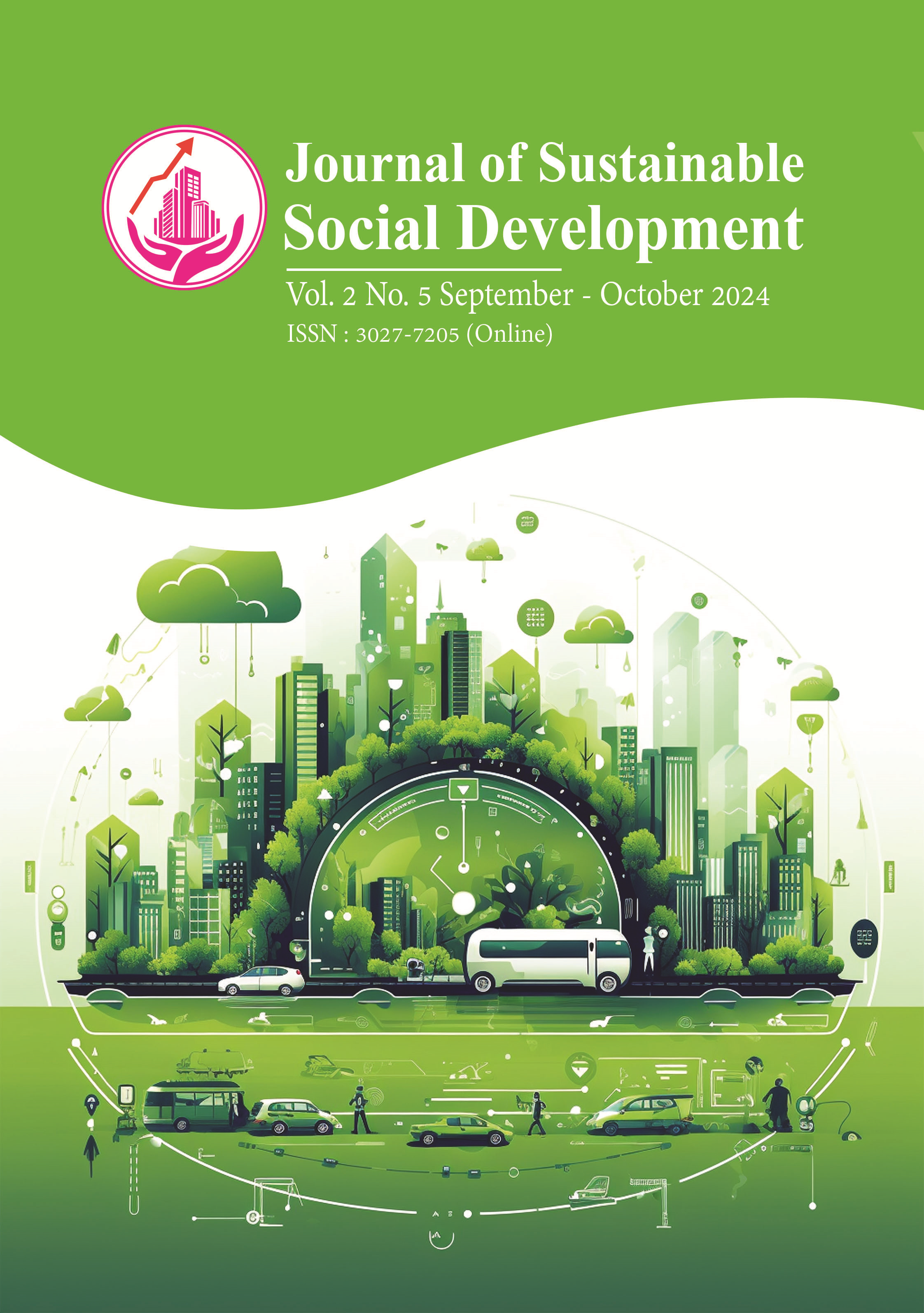Employee Engagement Factors and Engagement Assessment for Organizations
Main Article Content
Abstract
Regardless of the era of organizational management, organizations should give importance to the feelings and minds of their personnel in the organization, especially focusing on creating employee engagement, which will make employees determined and dedicated to the organization’s success. Such characteristics can be created by many factors. Therefore, organizational engagement is the employee’s feeling of attachment to the organization, consisting of 3 aspects: acceptance of the organization’s goals, willingness to work, and the desire to remain a member of the organization. Organizational engagement is divided into 3 types: 1) Employees with this type of engagement arise from personal feelings; 2) Employees with this type of engagement arise from individual calculations based on the investment that individuals make to the organization and the returns that individuals receive from the organization; and 3) Employees with this type of engagement are engagement that arises in return for what individuals receive from the organization. The components of organizational engagement include emotional engagement, retention engagement, normative engagement, behavioral engagement, and attitudinal engagement. The factors that affect organizational engagement include 6 factors: company, executives, work groups, work done, career, and customers.
Findings Factors affecting organizational commitment consist of 4 factors as follows: Personal characteristics: gender, age, working years, education, and marital status; Scope or role of responsibility: challenging nature of work, participation in management, opportunities for advancement in many careers, independence in the work that is responsible, and clarity of the assigned scope; Experience in the work that is responsible: trust in the organization, feeling important to the organization, and guidelines for evaluating performance or merit of the organization; and Organizational structure: decentralization, participation in business ownership, and participation in decision-making.
In summary, the factors that influence organizational commitment consist of 4 factors: 1) Personal characteristics: gender, age, working years, education level, and marital status; 2) Scope or role of responsibility: challenging nature of work, participation in management, career advancement opportunities, freedom in the work that is responsible, and clarity of the assigned scope; 3) Experience in the work that is responsible: trust in the organization, feeling important to the organization, and the evaluation of performance or merit of the organization; and 4) Organizational structure: decentralization, participation in business ownership, and participation in decision-making.
Article Details
References
ประเวศน์ มหารัตสกุล. (2554). องค์การและการจัดการ. กรุงเทพมหานคร: ปัญญาชน.
ปราโมทย์ จิตต์ไพโรจน์. (2548). ความผูกพันของบุคลากรทางการศึกษา ในสำนักงานเขตพื้นที่การศึกษาเขตตรวจราชการที่ 7 กระทรวงศึกษาธิการ. สารนิพนธ์ปริญญาการศึกษามหาบัณฑิต. บัณฑิตวิทยาลัย: มหาวิทยาลัยศิลปกร.
พัชรินทร์ คีรีเมฆ. (2560). ความผูกพันต่อองค์กรของครูและบุคลากรในโรงเรียนเอกชน สังกัดสำนักงานเขตพื้นที่การศึกษาประถมศึกษานครสวรรค์ เขต 1. นครสวรรค์: มหาวิทยาลัยราชภัฏนครสวรรค์.
พิชิต พิทักษ์เทพสมบัติ, จินดาลักษณ์ วัฒนสินธุ์ และไชยนันท์ ปัญญาศิริ. (2552). ความพึงพอใจในงาน และความผูกพันต่อองค์กร: ความหมาย ทฤษฎี วิธีวิจัย และการวิจัย. กรุงเทพมหานคร: เสมาธรรม.
รักษ์รัศมี วุฒิมานพ. (2555). ลักษณะบุคคลและลักษณะงานที่มีความสัมพันธ์กับความผูกพันต่อองค์กรของพนักงาน. สารนิพนธ์ปริญญามหาบัณฑิต สาขาวิชาการจัดการ. บัณฑิตวิทยาลัย: มหาวิทยาลัยศรีนครินทรวิโรฒ.
วาริกา ริ้วเหลือง. (2553). การศึกษาความผูกพันต่อองค์การของไทย A Study of Thai Organization Commitment. วารสารการเมือง การบริหารและกฎหมาย. 2 (2), 125-160.
วิรัช สงวนวงศ์วาน. (2560). พฤติกรรมองค์การและการจัดการ. กรุงเทพมหานคร: มหาวิทยาลัยรามคำแหง.
วิเชียร วิทยอุดม. (2559). ทฤษฎีองค์การสมัยใหม่. กรุงเทพมหานคร: ธนธัชการพิมพ์.
สิทธิโชค วรานุสันติกุล. (2556). จิตวิทยาองค์กร. กรุงเทพมหานคร: สำนักพิมพ์บุ๊คแบงค์.
สุกานดา ศุภคติสันติ์. (2540). ลักษณะส่วนบุคคลและสภาพแวดล้อมขององค์การที่มีความผูกพันต่อองค์การของพนักงาน : กรณีศึกษาเงินทุนในเขตกรุงเทพมหานคร. วิทยานิพนธ์ปริญญาพัฒนบริหาร ศาสตรมหาบัณฑิต สาขาวิชาพัฒนาทรัพยากรมนุษย์ สถาบันบัณฑิตพัฒนบริหารศาสตร์.
สุนาภา คุ้มภัย. (2552). ความผูกพันของบุคลากรต่อหน่วยงานราชการ : กรณีศึกษากรมชลประทาน. วิทยานิพนธ์ปริญญามหาบัณฑิต บัณฑิตวิทยาลัย มหาวิทยาลัยศิลปกร.
Bhatnager, J. (2007). Talent Management Strategy of Employee Engagement in Indian ITES Employee: Key to Retentions. 29 (6), 640-663.
Bruce, B. (2005). Building Organizational Commitment: The socialization of managers in work organizations. Administrative Science Quarterly, 19 (4), 533-546.
Buchanan, H.B. (1974). Building Organization Commitment the Socializatoin of Managers in Work Organization. Administrative Science Quarterly, 24 44-53.
Dunham, R.B. , Grube, J.A. and Castaneda, M.A. (1994). Organizational Commitment: The utility of an integrative, Journal of Applied Psychology, 79 (3), 370-380.
Meyer.J.P. and Allen, N.J. (1997). A Three-component Conceptualization of Organizational Commiment. Human Resource Management. Review, 1, 61-88.
Mondy, R.W., and Neo, M.R. (2004). Human Resource Management. 9th ed. Upper Sadler River, New Jersey: Prentive-Hall.
Mowday, R.T.., Porter, L.W. and Streers, R.M. (1979). The Measurement of Organizational Commitment, Journal of Vocational Behavior, 14, 224-227.
Porter. (1974). Organizational Commitment, Job Satisfaction and Turnover Among Psychiatric Technicians. Journal of Applied Psychology, 59, 603-609.
Steers and Porter. (2003). Motivation and Work behavior. (3rd ed.). New York: McGraw-Hill.
Steers, R.M. (1977). Antecedent and Outcomes of Organizational Commitment. Administrative Science Quarterly, 22, 46-56.


